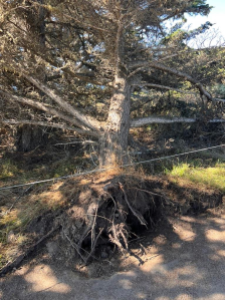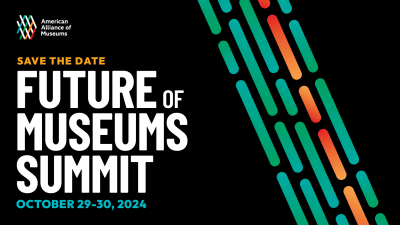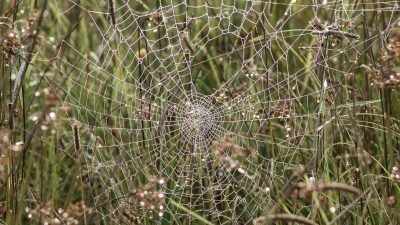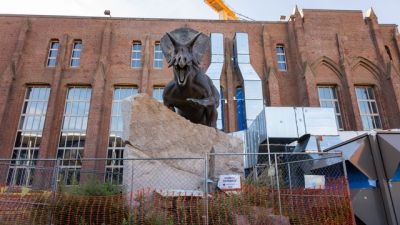
Earlier this year, I had the opportunity to join the AAM team for two wellness sessions in the lead-up to May’s Annual Meeting & MuseumExpo. Given the meeting’s wellness-focused theme, “Thriving Museums, Healthy Communities,” the team wanted to set the tone and learn how to manage their own health and well-being as they went into the busiest months of planning for the meeting.
As the tracks for this year’s conference emphasized, wellness is not just something organizations can create externally, but something they can cultivate internally. In that spirit, I am writing this post to share the framework and lessons we used in our work so that staff of other organizations can also spend time tending to their well-being. I hope you will take time to follow along, whether individually or with a group, and prioritize the reflection and emotional openness that makes us all more joyful and effective as we work to impact the outer world.
Session One: Wellness Begins Within
The first session was a deep dive into where and how we get the support we need to move through the world. There are many messages available to us every day about self-care, wellness, fitness, and beyond. Many of those messages start with the premise that who and how we are is insufficient or incomplete in some way. We need to adjust this mindset. This adjustment can be grounded in, “You are whole, complete, and perfect just as you are. Nothing is wrong.” If we begin from here, then more positive choices are available that can be empowering, freeing, and uplifting for yourselves, your museums, and your communities. Beginning with our own wellness journeys, we are better equipped to assist others.
Part One: If You Really Knew Me…
Our session opened with a check-in, where we paused for one minute each to complete the sentence: “If you really knew me, you would know…” Each person shared whatever was on their mind and what they needed to be fully present and engage in the session. For many, this was the first time they had been asked to answer a question like this at work, and they eagerly participated, sharing details about hobbies, likes and dislikes, and secret talents that their coworkers had never known about.
Part Two: Levels of Healing
After our check-in, we reviewed the key points from an article by the National Equity Project called “Levels of Healing,” recommended by Grace Stewart, AAM’s Director of Equity and Inclusion. The article outlines several different levels of healing through a race equity lens to consider as you think about wellness:
- Individual Healing: Healing from institutionalized racism, finding your voice, your agency to express yourself fully.
- Interpersonal Healing: Intentional desire to reconnect with one another through storytelling, listening, and believing in one another. When we separate from each other—disconnect—we are being led by white supremacy, which keeps trauma alive while we suffer alone.
- Institutional Healing: An intentional commitment to creating a system/space for healing and care. Leaning into shared leadership instead of traditional top-down leadership. Community agreements on how to be with each other are key.
- Structural Healing: Pausing to unpack how things got to be how they are. The laws and policies that were designed to protect some and harm others. New co-created laws and policies must be established where everyone is seen, heard, and celebrated for who they are—safety for all.
As we reviewed each level, I asked for volunteers to share which they wanted to focus on in their reflections and why. The conversation was intimate and invigorating.
Part Three: We Are Like Trees

Next, I invited participants to reflect on their lives and determine what resources they can use to deepen their foundational roots. To illustrate this concept, we used the analogy that we humans are like trees, with root systems to support us as we move through our lives. Like trees, the deeper the roots, and the more connected they are to sustenance like nutrients and water, the better the chances are for survival. Also like trees, humans are resilient beings. Regardless of where our roots land—in rocky soil, in the cracks of sidewalks, in shady areas like illness, trauma, or divorce—we survive. The goal of our first session was to identify where and what our root system is comprised of so that we could not just move through the motions and survive, but move beyond negative experiences to thrive, with an abundant sense of “LIFE” (love, integrity, freedom, and ease) in our lives.
Part Four: Self-Guided Visualization
After this lesson, we moved onto an independent visualization exercise where I asked everyone to spend an extended block of time pondering a set of questions that walked them through the stages of their lives. I strongly encourage you to try this exercise out for yourself, taking notes on what comes up for you as you go through:
- Let us travel back to our elementary school years. What lessons and messages did you receive about how to take care of yourself, be safe, and develop tools for life? What did you learn at school? From your parents, immediate, and extended family? Keep breathing—there may be hurtful memories that present themselves. Let them move through you. All are welcome here.
- Now let us move onto the middle and high school years. What life skills and tools did you acquire, and from whom, for creating safety for yourself? Keep breathing. Things may be coming up, but know that you are on the other side of that now and you are safe.
- Now you are in your adult years. You are responsible for managing your life affairs—money, transportation, career, relationships, and more. What choices did you make to support you during this time?
- It is now the present day. Because of, and despite, all that came beforehand, you continue to explore and create new ways to support yourself. Are you seeking therapy, engaging in a spiritual practice, supporting yourself physically, emotionally, intellectually, spiritually, and beyond?
Finally, focus on what is currently fortifying your root system. Are there things to let go of? New things to explore? Are some of your roots on shallow ground and needing attention? What actions do you plan to take to fortify your roots?
Humans are resourceful and can identify, acquire, and release elements of our root system at any time. The key is to slow down enough to reflect and determine what is sourcing our lives. For some it is faith, religion, relationships, self-care practices: yoga, meditation, therapy, ecstatic dance, and beyond. Once we see what has been propping us upright, then we can choose if those are the best options for who we are now and who we are becoming, or if we need to make a change. The deepening of our roots will sustain us as the winds of change, challenges, and obstacles that may threaten to uproot us show up in our lives.
Part Five: Nurturing Your Root System
No matter where your root system originates from, even from trauma and fear, there is nothing “wrong” with it. But there may be areas that you find you want to change going forward, so you can deepen your roots and thrive more fully. As you explore these origins, grant yourself grace as you distinguish what you are doing and how you are being with your current root system. Are there any changes you would like to make?
Here are some things for you to ponder about the integrity of your root system:
- What are your practices that support your root system? For example, they may be meditation, yoga, journaling, therapy, etc.
- Are any of your current practices hindering your root system? Are you avoiding any actions that would be helpful, or choosing any actions that are numbing and distracting you from evaluating your life?
- What actions do you need to take to ensure that your roots are getting the nutrients you need to weather the storms and opportunities in your life? Do you need to get any support? Do you need to make a list of what you are or want to do? Do you need an accountability buddy to support you?
How can you apply the tree analogy to your museum and communities? Now that you have had an experience of comparing your life to a thriving tree, how can you share that with your team members, museums, families, and beyond so that they can benefit too?
Life will continue to provide opportunities for growth, and we do not need to perceive them as “bad.” By right of consciousness, anything that shows up in our life can be interpreted as either insurmountable obstacles and threats or opportunities to expand our thinking, feelings, and root systems. You are invited to explore the latter with curiosity and an open heart—your experiences will be more fruitful and life-giving.
Skip over related stories to continue reading articleSession Two: Dimensions of Wellness
In our second session a month later, we dug deeper into what we had uncovered in our previous exercises and reflected on what areas of our lives we might need to tend to.
Part One: Shares from Our First Session
To build the bridge between sessions, I asked for volunteers to share what had come up for them in the time since our last meeting:
- How have you been nourishing your root system? Have you engaged in anything new? Are there still things for you to try out?
- What are your immediate, short-term, and long-term wellness needs and goals?
- Have you identified resources (people, organizations, etc.) to support you?
What is true or not true about your current organizational culture that supports, or can support, your wellness goals?
Part Two: The Eight Dimensions of Wellness
After that, I introduced the team to another helpful framework for going deeper into their wellness journey, the eight dimensions of wellness:
- Emotional: Become more aware of your feelings and accept them as valid indicators of what you are experiencing.
- Spiritual: Explore your personal values.
- Intellectual: Strive to be open to new experiences and ideas in all areas of your life.
- Physical: This encompasses all areas of health that relate to the physical aspects of the body including nutrition, exercise, and weight management preventions.
- Environmental: Become aware of how your external environment affects you.
- Financial: Learn how to gain control of your finances so they work for you.
- Occupational/Vocational: Derive personal satisfaction and enrichment from one’s work.
- Social: Build a sense of connection and a dependable support system.
Part Three: Journaling Prompts
Next, I invited the participants to engage in another self-guided exercise, this time journaling about how the dimensions of wellness resonated with them. The questions we answered were:
- Out of the eight dimensions of wellness, which one(s) require your attention now?
- At your organization, which areas can you focus more attention and create intentions that would support everyone to thrive?
What support do you need to experience freedom in each dimension?
Both sessions were designed to help participants take care of themselves first before venturing out to serve their staff, museums, and communities. They can easily be adapted to support any audience, from professional development groups to parents and families. Regardless of our identities, whether age, socioeconomic status, race and ethnicity, sexual orientation, or beyond, we are all given one tree trunk in this lifetime. So, let us act with intention as we place our attention on well-being so that we are all thriving as we expand and strengthen our root systems.
I am grateful for Grace Stewart’s invitation to collaborate with the AAM team. Many additional big-hearted and brilliant team members participated, including key members of the leadership team. This experience reaffirmed my belief that humans inside organizations are willing to explore and heal individually and collectively. And that when we do, everyone benefits. Thank you for allowing me to witness your transformation, and the transparent deep care and support you offer to yourselves and each other effortlessly.








Comments